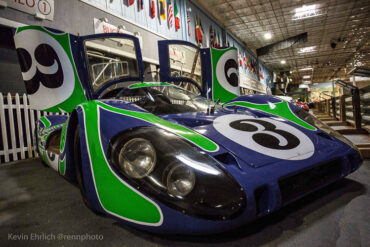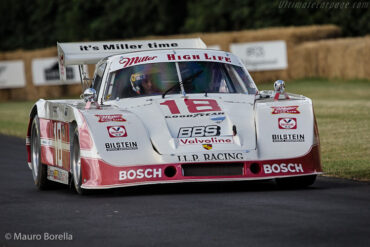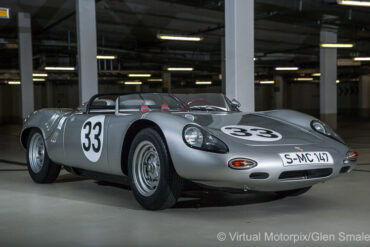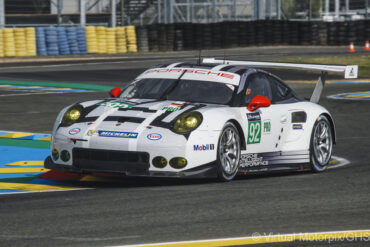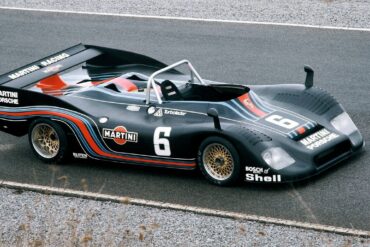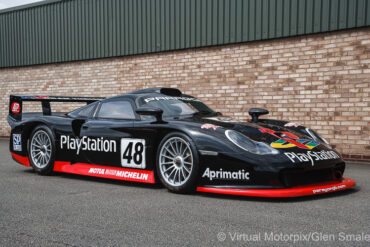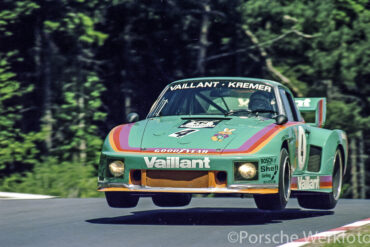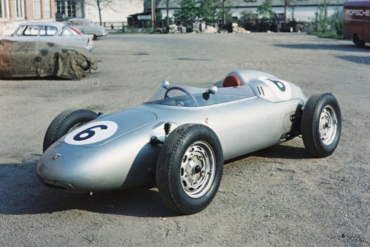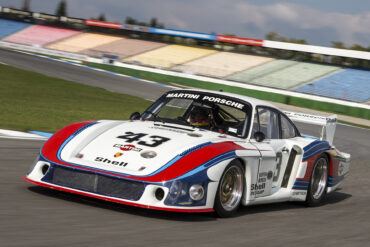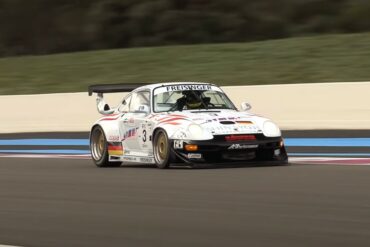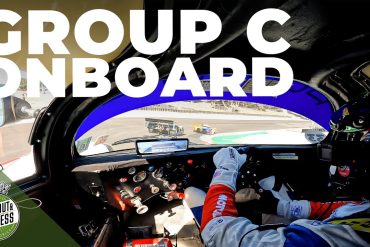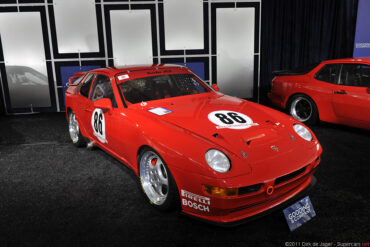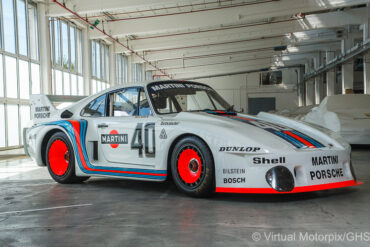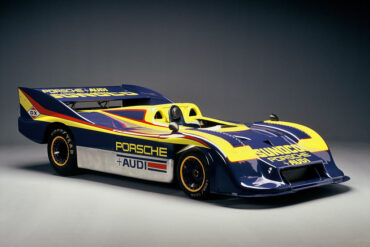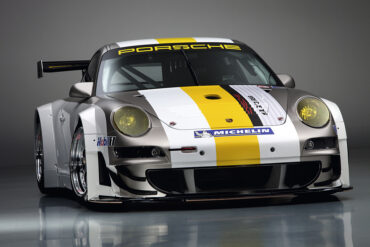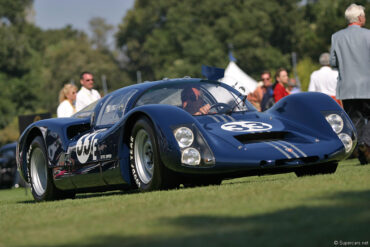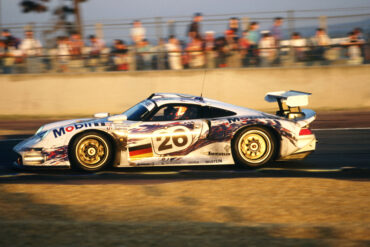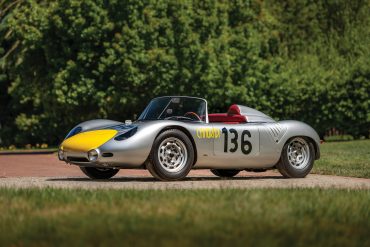The Porsche 908/3 is undeniably a unique car. Specifically crafted by Porsche for competition on only two circuits during the...
Simeone Foundation Museum – 1970 Porsche 917-043 While diplomats and cartographers may technically show the roads around Le Mans as...
Porsche 935 JLP-4 at the Goodwood Festival of Speed, 2014 JLP-4 was the final race car in the line of...
1961 Porsche 718 W-RS Spyder ‘Grossmutter’ (chassis #047) photographed at the Porsche Museum, May 2019 The word unique is a...
The #92 Porsche 911 RSR of Makowiecki/Bamber/Bergmeister negotiates the Ford Chicane during the 2016 Le Mans 24H From the very...
The Group 6 Porsche 936 was the successor to the 908/03 and the turbocharged 917. While the 917 had a 5.4-litre flat-12 biturbo engine, the 936 got a 2.1-litre flat-6 single turbo engine. The reason for the 2.1-litre displacement was to fit inside the 3-litre class (turbocharged cars had a coefficient of 1.4). Despite the small capacity, the engine developed more than five hundred horsepower. Imagine such power in a ~700 kg/1540 lb car!
1997 Porsche 911 GT1-109 photographed in June 2016 Porsche 993 GT1 chassis #109 was one of just nine customer racing...
Le Mans 24 Hours, 9/10 June 1979: Its a tense time as the lead car, the #41 Numero Reserve Kremer...
In 1959 Porsche unveiled the prototype of a narrow, open-wheeled car called the Porsche 718/2 that married the 718's mechanicals with a more traditional single-seat Formula body. For 1960 the production 718/2, starting with chassis number 718201, received revised bodywork, a 6-speed transaxle, and a wheelbase extended by 100 mm. A total of five cars were built. Some of these four-cylinder cars were later raced in F1 under the 1962 1½ litre formula.
The 935/78 was the ultimate expression of the 911 factory race car before Porsche officially withdrew from motor sport. Raced...
The racing sportscar is prepared by Porsche following the Le Mans GT2 regulations for the over 1,150 kg weight classification. It features a 3.6-litre engine with two turbo-chargers (KKK 24 with 33.8 mm restrictors), which delivers around 450 hp at 5,750 rpm. Even this racing vehicle, with its suspension featuring a McPherson front axle and Porsche multi-link rear axle with LSA system, closely resembles its production relative. Utilizing a steel 993 Twin Turbo chassis with modifications for racing, scored numerous victories in a wide variety of racing venues.
Watch this onboard video featuring the 1986 Le Mans 24 Hours-winning Porsche 962 hustled around the Laguna Seca during a...
In 1992, Porsche introduced the 968 Turbo RS racecar which it developed to compete in the new ADAC GT racing series in Germany. The car was based on the 968 coupe with limited lightening due to the regulations of the series which had a 4kg/bhp power/weight ratio limit. The car featured a K27 turbo boosting the 3.0 litre, 4 cylinder engine and an 8V head, similar to the 944 Turbo S, rather than using the 16V 968 head.
The 1977 #40 Martini Porsche 935/2.0 Baby (chassis #935 2 001) photographed at the Porsche Museum, Stuttgart, Germany in May...
The final evolution of the 917 was created after Ferdinand Piëch had left the Porsche company in 1972. Two complete 917/30 Can-Am cars with 2500 mm (98.4") wheelbase were made for Roger Penske Enterprises racing team. They were chassis 917/30-002 and 003. The 001 car was not a real 917/30 and was raced in Europe at the Interserie. The Can-Am 917/30 had a 5.4-litre flat 12-cylinder twin-turbo engine which produced so much power that nobody really knew how much.
Porsche has announced the introduction of the new 2007 911 GT3 RSR (type 997) for the American Le Mans Series and other world GT racing venues. The latest version of the most successful racing sports car in history is based on the street production model 911 GT3 RS (model year 2007) and was launched in late 2006. The 911 GT3 RSR has wider rear fenders and rear track to improve performance capabilities over its predecessor. The car has also been developed to fit into the 1,225 kg class. The new car is built in accordance with the ACO LMGT2 Regulations and the FIA Article 257.
The technology in racing during the mid 60s was shifting from carburetors to fuel injection. Porsche began experimenting and the Bosch injection system proved to be the most reliable. Though the performance did not increase, it did provide superior throttle response over the Weber carburetors, and it was easier to tune. To compliment the new engine, a new body was created which reduced drag levels. Porsche dubbed the resulting car, with its new engine and body work, the 906E, with the 'E' representing 'Einspritzung, or injection.
In spite of its 911 moniker, the car actually had very little in common with the 911 of the time, only sharing the front and rear headlamps with the production sports car. Designed and developed to compete in the GT1 class of sportscar racing, which also required a street-legal version for homologation purposes. It was powered by a twin-turbo flat 6 that was good for 600 bhp. The 1996 911 GT1 clocked at a top speed of exactly 330 km/h (205 mph) on the legendary Mulsanne Straight.
Despite being made for the small engine displacement classes, Porsche nearly won the 1960 Manufacturers Championship with the RS 60....
No More Content



